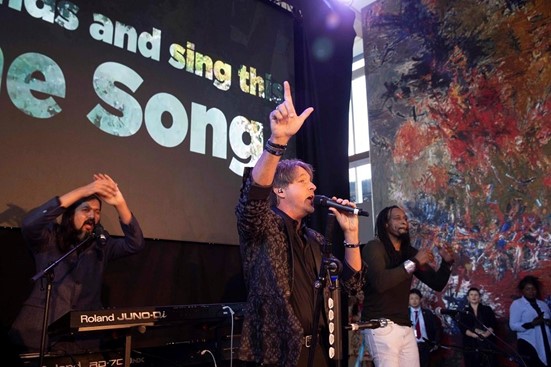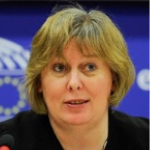June 2, 2021 | In her latest blog, Lidia Best shares her personal experience as a cochlear transplant recipient and the role that music has played in her life. Through her blog, Lidia helps readers understand the experiences that cochlear implant users face in everyday listening experiences with music. Read the complete blog.
When I experienced a partial hearing loss episode as a 12 year old, I took it in my stride like young people usually do. Thanks to excellent support from hearing care professionals, friends, and family, I have adapted quite well.
When it happened in my 40s in the space of just few months, and all the remaining hearing disappeared, it was a very different story. The tinnitus became unbearable as there was no longer any possibility to mask it with a hearing aid. To be honest, I was not prepared for becoming deafened so early and naturally, I was terribly upset, and daily experiences of misunderstanding have not helped. One of upsetting aspects was how my deafness has affected my children, our normal ways of communicating and the rest of the family.
I found all this too much to deal with and took a break from work while I tried to reassess my next steps, one of them was to undergo assessment for a cochlear implant. I have always been fiercely independent – so having no control over the situation was hard to take. I also missed hearing music I loved. Music makes us sad or happy, music transports us into this magical place, the inner soul which I could only try and recreate playing in my head. I was worried, the longer I stay deaf I will forget what music sounds like, feeling vibrations was not enough for me, I longed to hear those sounds I remembered.
Music played a particularly important role when I started to hear again thanks to the cochlear implant. Music and its richness as I remembered was no longer there, the mechanical sound that the implant gave me in the early days of adaptation was disappointing and I thought, I would never hear the same as before. I listened to my favorites: Bee Gees and George Michael songs, yet Bee Gees sounded like a highly strung and stressed parrot! No kidding!
Following advice and support of my peers and the excellent cochlear implant team things quickly improved. I kept listening to music I knew, and after a while my brain started to recognise the music played and connected sounds with my auditory memory. Finally, the puzzle pieces started to fall in place and 3 months later, I was the happiest person in the world listening to music and even understanding the lyrics! The way I hear now is not the same as I heard in the early days of implant activation, it is still not 100% natural hearing but I am happy, I hear life and the music!
Regaining my ability to hear again has given me an amazing confidence boost, and I have my independence back. The defining moment of losing my hearing and realizing that I have so much more to give had a profound effect in how I see myself in the scheme of things.
Since then, I have been involved in hearing loss advocacy, which ultimately led me to become one of the experts at the Making Listening Safe initiative of the World Health Organisation, committed to create a world where nobody’s hearing is put in danger due to unsafe listening. I was present at the WHO HQ in Geneva when Grammy award-winning musician Ricky Kej performed a “Sound of Life” concert at the World Health Organization on 14 February 2019 to help launch the first-ever global standard for safe listening devices, aimed at raising awareness and inspiring action to prevent sound-induced hearing loss.
The concert started with few signature songs and we all joined in celebrations. Ricky announced they will play a new song, “Sound of Life”, written in celebration of music and sounds of life, which can be so easily lost if we are not listening to music responsibly, specially created as part of the Safe Listening campaign.

Listening to Lonnie Park – belting out the lyrics while everyone danced around, I simply froze as the memories of the implant’s early days came flooding back in the moment and I cried, but those were tears of joy and happiness.
“I feel strongest of emotions, in those whispers soft and clear
Rolling sweetly of your tongue and gently into my ear
All those invisible waves, straight of my heart
“I can hear it, the beautiful sound of life,
can you hear that,
the beautiful sound of life?”
SOUND OF LIFE
These words described my feelings of elation when I returned home from the appointment to have my cochlear implant activated and shared the news with everyone – Yes “I can hear it, the beautiful sound of life!”
Thank you, Ricky and Lonnie, it is a beautiful tribute to all those wonderful sounds that surround us! Incidentally, you have given this song additional and unexpected meaning.
Thanks to the cochlear implant, I am able to hear again, the gift of hearing is precious…..
Listen to “Sound of Life” and watch with creative lyrics on YouTube. You can also listen to “Sound of Life” on Spotify.
(This blog was originally published on the See Hear Inclusion website.)
Author information:

Lidia is President of the European Federation of Hard of Hearing People and Vice-Chairman of ITU JCA-AHF (International Telecommunication Union Joint Coordination Activities on Accessibility and Human Factors) and internationally recognized accessibility expert and advocate for persons who are deaf or hard of hearing. She brings unique knowledge as an expert with lived experience, as a person who is hard of hearing and a cochlear implant user since 2009. Her work has specific focus on accessibility and quality of hearing care for deaf and hard of hearing people including policy development, training, and consulting. She contributed to work on standards as a member of G3ict delegation to ITU in telecoms, captioning and assistive listening devices , having authored the ITU FSTP-RCSO “Overview of remote captioning services" and H.871“Safety requirements for wearable audio augmenting devices” the recommendation on personal sound amplifiers. After 10 years, Lidia stepped down from her position of the Vice-President of the EFHOH (European Federation of Hard of Hearing) in 2020 to concentrate on international advocacy work which includes WHO World Hearing Forum. While at EFHOH she was co-author of reports into situation of hard of hearing and deafened people in Europe in areas of employment, hearing care and accessibility. In UK, Lidia is a Chairman of the National Association of Deafened People (NADP).